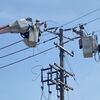Processing Your Payment
Please do not leave this page until complete. This can take a few moments.
Maine tops the US in many types of recycling, but there’s room for improvement
 COURTESY / ECOMAINE
Maine tops the nation in the rate of recycling common packaging materials. But more can be done, a new report says.
COURTESY / ECOMAINE
Maine tops the nation in the rate of recycling common packaging materials. But more can be done, a new report says.
Mainers top the nation in their recycling of many common materials, a new study has found.
The “50 States of Recycling” report, released last week by Eunomia Research & Consulting and Ball Corp., said Maine recorded a recycling rate of 65% in 2021 for a variety of packaging materials. They included aluminum, glass and polyethylene terephthalate, a rigid plastic usually referred to as PET and used for things like soda bottles.
Maine’s recycling performance increased to 67% when fiber materials and flexible plastics were considered in the mix.
Maine’s efforts have been supported on multiple fronts. Maine’s electronic waste recycling law passed in 2004 and was implemented in 2006, allowing the state to bill manufacturers for the cost of recycling their TVs and computer monitors, which can contain toxic chemicals like mercury and lead. Maine was the first state in the country to pass a “producer responsibility law.”
In 2020, the Manufacturers Association of Maine instituted a “Waste to Wares” initiative to encourage manufacturers to cut waste. At Allagash Brewing Co. in Portland, that included examples such as collecting corks from specialty bottles and shipping them to a company that turns them into yoga blocks and sandals. The company also reuses packing materials from peanuts to bubble wraps on outgoing shipments and donates stainless steel leftovers to a vocational tech program for welders.
Other waste-reduction efforts include the work of GoGo Refill, a business in South Portland and Brunswick that helps people reduce their plastic waste by offering household products in bulk, which customers can pack in their own containers. In addition, a project initiated earlier this year by the Maine Sea Grant College Program, University of Maine researchers and statewide partners to promote sustainable packaging as part of an overall effort to remove plastic and microplastics in the ocean.
Monetary benefits
Total annual benefits of Maine’s recycling rate amounted to $262.9 million in 2021. That included the gross value added to the economy, excluding wages, of $59.1 million; wages, for the equivalent of 1,463 jobs, of $79.3 million; $26 million for the value of the material captured for recycling, which represented 69% of the total value of material that could be captured for recycling; and $98.3 million in avoided greenhouse gas emissions of 515,000 metric tons of carbon dioxide annually.
“Maine has been a leader in recycling legislation, adopting some of the most progressive laws in the country,” the report says. “These include the nation’s first electronics recycling bill and bans on single-use plastic carrier bags and expanded polystyrene food containers.”
The report continued: “Maine’s system is one of the most comprehensive, covering the widest range of beverages of any” deposit return scheme in the U.S.
The report says Maine could do better through improved producer responsibility and recycling refund policies, which together could increase recycling related jobs to 1,600 or more, place $27.9 million of recycled material back in the market to support a circular economy and reduce the need for virgin material and avoid emissions of 520,000 metric tons of carbon dioxide annually.
Improvements could result in a $19.1 million increase in total annual benefits, to $282 million, the report says. That figure breaks down to gross value added to the economy, excluding wages, of $66.2 million; wages of $88.8 million; $27.9 million for the value of the material captured for recycling; and $99.1 million in avoided greenhouse gas emissions of 520,000 metric tons of carbon dioxide annually.
Maine was followed by Vermont (51%), Massachusetts (48%), Iowa (45%) and Oregon (45%).
Maine also led the way in 2018, according to the inaugural “50 States of Recycling” report released in 2021.
According to the report, Maine was among nine of the top 10 states to have recycling refunds, also known as bottle bills or deposit return systems.
While states with recycling refunds only account for 27% of the U.S. population, they account for 47% of all packaging recycled, 51% of all aluminum cans and glass bottles recycled and 61% of all PET bottles recycled.
State efforts
But the report doesn't reflect a broader and more complicated topic that's being tackled by the Maine Department of Environmental Protection through its planning process for 2024.
Over the past year, the department hosted public sessions as part of its process to draft a 2024 plan for overall waste reduction, including recycling of items such as electronics in addition to packaging; managing, reducing and recycling solid waste; and composting.
Common themes included:
- More regionalization is needed, especially in rural areas
- Materials management should be treated as a necessary public utility so diversion programs for recycling, composting, etc. aren’t cut out in favor of the cheaper option of disposal.
Maine law requires municipalities to provide solid waste disposal services and demonstrate reasonable progress toward statewide recycling and waste reduction goals. But there were concerns about municipal capacity, data tracking and workloads to participate. There's also been concern about some types of waste, including lithium-ion batteries, household hazardous waste and e-waste.
The department has developed priorities that include elevating waste reduction over recycling, more support and infrastructure for organics diversion, deconstruction and programs to reuse, refill and repair.
The department is gathering data to characterize all materials disposed across the state including demo debris and municipal solid waste, assess residential food scrap management and the existing organics transportation system. It is studying food loss and waste or surplus food that could be diverted to higher and better uses, including food rescue, animal feed, or composting/anaerobic digestion. And it is administering data tracking, analysis and reporting on waste diversion activities around the state, while also enforcing single-use plastic bans on plastic bags and polystyrene foam food service items.
A ban on single-use plastic bags was originally scheduled to take effect in April 2020. But the pandemic led the Department of Environmental Protection to twice delay enforcement — initially, because of the concerns about transmission of the COVID-19 virus on reusable bags, and then due to disruption in the packaging supply chain.
The ban was finally implemented July 1, 2021, as the third such statewide measure, after California’s and New York’s.
Last year, the department awarded $182,000 in grants for six recycling and composting projects from South Portland to Sargentville.
Recipients included Northern Aroostook Solid Waste Association to enhance recycling infrastructure in Eagle Lake and MaineHealth in Portlandfor food scrap composting and recycling upgrades.
National data
Nationally, the value of material diverted from landfills is $2.6 billion, which only represents 32% of the value that could be captured annually.
There is around $6.5 billion worth of material that is lost to landfill annually that could be captured through more effective recycling practices.
Since the report’s last iteration of the "50 States of Recycling" report, overall recycling rates across the country have stagnated or declined. Several factors contributed to the declines, including pandemic-related shutdowns at many recycling centers.
Currently, the U.S. recycles just 45.2% of aluminum cans. Getting that recycling rate closer to 90% by 2030 would create opportunities to reduce greenhouse gas emissions: In 2021, 79 million metric tons of carbon dioxide were avoided through recycling, comparable to removing more than 17 million vehicles from the roads, the report says.
The recycling rates in the report represent the “real” recycling rate, versus the collection rate — meaning the rate is not what is collected for recycling, but rather what is available to be made into new products.
“Real” recycling is a closed-loop system where a can becomes a can or a bottle becomes a bottle, the report says.
In many states, recycling rates are measured in terms of what is collected for recycling.
The total economic value of recycling in the U.S. is approximately $35 billion, accounting for gross value, employment income from recycling-related jobs and greenhouse gas impact reduction and comparable to removing more than 17 million vehicles from the roads.
The report says there’s a need for more accurate data, policy and infrastructure investment to improve statewide recycling rates.
“If effective recycling policies were enacted nationwide, such as pairing extended producer policy alongside recycling refunds, the benefit of recycling would double to $70 billion annually,” the report says.
Ball Corp. (NYSE: BALL) started in 1884 in Buffalo, N.Y., as the maker of the familiar glass home-canning jars. Today, Ball produces aluminum packaging, as well as aerospace and other technologies and services, with 2022 net sales of $15.35 billion.
Established in 2001, Eunomia Research & Consulting is an international environmental consultancy headquartered in Bristol, England.










0 Comments